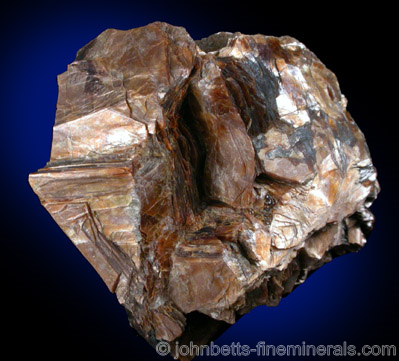The Mineral phlogopite

Phlogopite is a common form of mica, and it is usually distinguished by its brownish-red color. Phlogopite, like the other important mica's, can come in
very large crystal sheets. Thin
sheets can be peeled off as layers, and thin layers maintain an interesting metallic-looking transparency.
Biotite, another common mica, is recognized by the IMA as a mineral group of related micas rather then as an individual mineral type. Phlogopite is one of the member minerals of the Biotite group, and is chemically and structurally similar to the other Biotite minerals. It represents the magnesium rich end member of the Biotite group, whereas the other forms of Biotite are rich in iron.
Phlogopite contains three closely related minerals (some consider these as varieties):
- Tetraferriphlogopite: KMg3(Fe3+Si3O10)(OH)2
- Shirozulite: KMn3(AlSi3O10)(OH,F)2
- Fluorophlogopite: KMg3(AlSi3O10)F2
Phlogopite is very hard to clean because if washed
it will absorb water internally and start to break apart. The best way
to wash Phlogopite and other micas is with a dry electric toothbrush.
Chemical Formula
KMg3(AlSi3O10)(OH,F)2
Color
Brown, reddish-brown, yellow-brown, yellow, gray, green, reddish-black
Crystal System
Monoclinic
Properties
Streak
Colorless |
Hardness
2 - 3 |
Transparency
Translucent. Transparent in thin sheets. |
Specific Gravity
2.8 - 2.9 |
Luster
Pearly |
Cleavage
1,1 |
Fracture
Uneven |
Tenacity
Sectile, Elastic |
Other ID Marks
May fluoresce cream-white to light yellow.
|
Crystal Habits
Crystals are in thick flakes, micaceous masses and groupings, and in
tabular, foliated, flaky, and scaly forms. Crystals may
also be elongated with one dimension flat, or stubby triangular or
hexagonally shaped crystals. Also forms in prismatic barrel-shaped crystals composed of dense parallel plates,
and rounded nodules of dense crystals.
Uses
Phlogopite, being a poor conductor of heat and
electricity, is used as an insulator for various electrical products. It is also used in the manufacture of spark plugs.
Noteworthy Localities
Exceptional gemmy hexagonally shaped Phlogopite barrels come from Sar-e-Sang, Kokcha Valley, Badakhshan Province, Afghanistan. Enormous crystals come from Betroka, Tulear Province, Madagascar. Other well know localities are Mogok, Burma (Myanmar); the Yaogangxian Mine, Hunan Province, China; Pargas, Finland; and Monte Somma, Vesuvius, Italy. Interesting rounded Phlogopite spheres come from Hermanov, Czech Republic.
In the U.S., the best examples come from Franklin, Sussex Co., New Jersey. Other Phlogopite locations in the Franklin marble belt are the Lime Crest Quarry, Sparta, Sussex Co., New Jersey; and Amity, Orange Co., New York. Very large crystals come Pierrepont, St Lawrence Co., New York; and from Canada at South Burgess, Ontario.
Distingushing Similar Minerals
Muscovite, Biotite - Can be hard to tell apart, although typical Phlogopite color is a different color then Muscovite and Biotite, and these are also not common in metamorphasized marbles where Phlogopite is found.